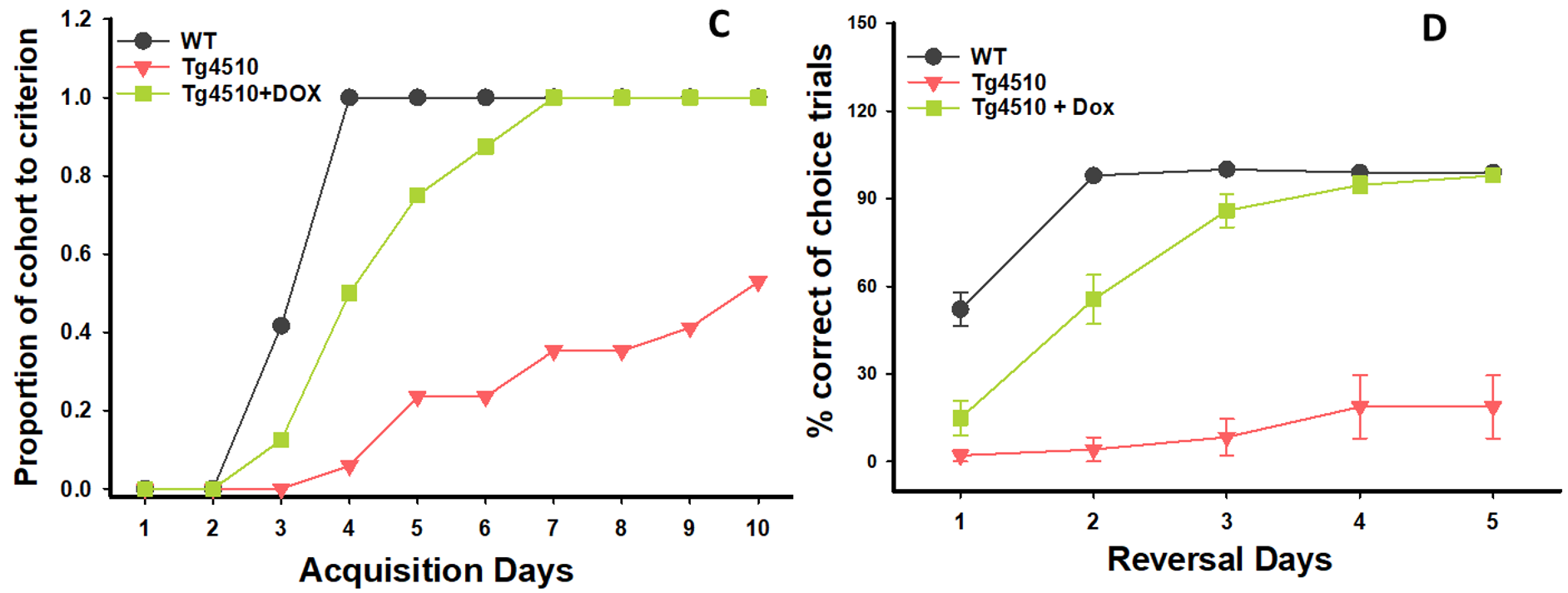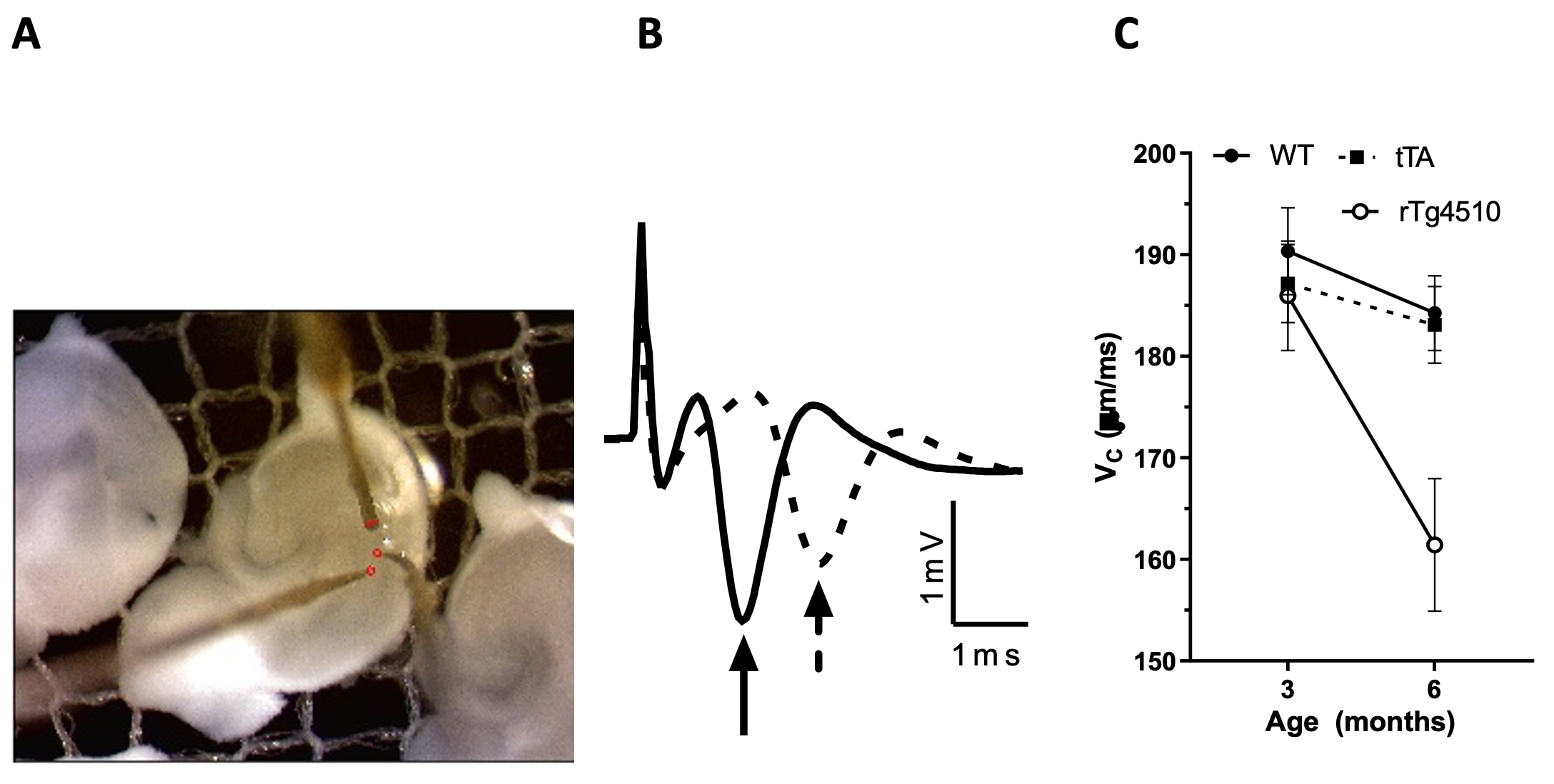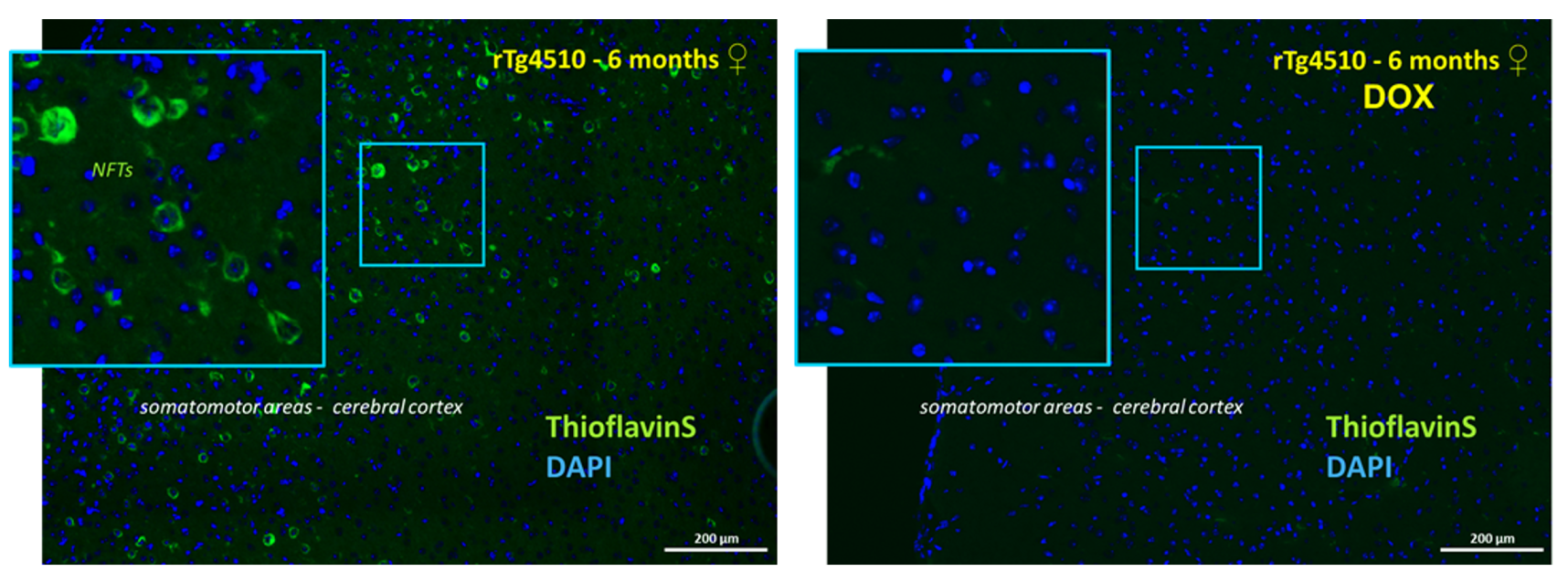Tg4510 Tauopathy Mouse Model – Inducible Expression of hTau (P301L) in Alzheimer’s Disease
Doxycycline prevents transgene expression – reverses cognitive deficits and stops neuronal death
Neurofibrillary tangles with accelerated amyloidosis and plaque formation are widely thought to play a major role in development of Alzheimer’s disease pathology. The rTg4510 mouse, a model of tauopathy, overexpresses P301L mutant human Tau in the forebrain. This line of mice exhibits an age-dependent and region-specific progression of neuropathology associated with cognitive impairment.
Behavioral Test:


Figure 2: Cognitive deficits in Tg4510 mice. Female Tg4510 mice (4 months old) show deficits in acquisition of the Morris Water Maze task (A) and spend less time in the correct quadrant during the probe test compared to either WT or tTA control mice (B). Female Tg4510 mice (6 months old) show deficits in acquisition of T-maze task (C) and reversal sessions (D). Doxycycline treatment attenuated the deficits seen during acquisition and reversal sessions (C&D).
Biochemistry:
Figure 2: Using quantitative qPCR (B) and western blotting (A&C), hippocampal soluble-, insoluble- and phospho-tau (A), inflammatory markers (B), and (C) autophagy markers were assessed.
Slice Electrophysiology:
Our assay offers an evaluation of therapeutics designed to improve both pre- and postsynaptic function of rTg4510 hippocampal CA3-CA1 synapses by evaluating basal synaptic transmission, including strength of excitation of pre-synaptic Schaffer collaterals, short- and long-term plasticity (paired pulse facilitation and long-term potentiation). For more information see our manuscript: Gelman et. al. (2018), Differences in synaptic dysfunction between rTg4510 and APP/PS1 mouse models of Alzheimer’s disease. Journal of Alzheimer’s Disease, 61: 195:208).
Hippocampal Long-term potentiation:

Figure 3: CA3-CA1 long –term potentiation (LTP) is impaired in six month old rTg4510 mice. (A) A time-course of evoked responses (fEPSP slope normalized to the baseline) from an LTP study showing a deficit in rTg4510 mice. No LTP deficit was observed in three month old mice (data not shown). (B) Summary of data taken from the last 5 minutes of recordings. Data are presented as mean ± SEM.
Conduction velocity of Schaffer collaterals in CA1 area of hippocampus:

Figure 4: Conduction velocity deficits. (A) An image of a hippocampal slice showing placement of stimulating and recording electrodes in the stratum radiatum layer of CA1. Electrodes coming from the bottom of the image are recording electrodes. (B) Representative recordings of compound action potentials (CAPs) from electrode 1 (full trace) and 2 (broken trace), located closer and further from the stimulating electrode, respectively. Arrows indicate the most negative points in CAPs that were used to determine the time difference in propagation. (C) rTg4510: Only 6 mo and not 3 mo old rTg4510 mice show a reduction in conduction velocity compared to age-matched controls. Symbols and error bars represent mean and 95% confidence intervals, respectively (Gelman et. al. [2020 accepted]. Axonal conduction velocity in CA1 area of hippocampus is reduced in mouse models of Alzheimer’s disease. Journal of Alzheimer’s Disease).
Histology:
Tg4510 mice are characterized by a strong and progressive Tau pathology and neuroinflammation. Starting with hyperphosphorylation at several AD relevant phosphorylation sites, Tg4510 progressively develop neurofibrillary tangles (NFTs) and severe brain atrophy. Synaptophysin or NeuN antibodies are used to detect morphological change such as synapse and neuron loss. Antibodies such as pThr231, pSer202 Tau, pThr181 and dyes like Thioflavin S are used to evaluate tauopathy. Activation of microglia and astroglia can also be measured by anti-Iba1 and -GFAP antibodies.

Figure 5: Pathological endpoints in seven months old female rTg4510 mice. (A) Tau hyperphosphorylation at Thr231, (B) hippocampal atrophy, (C) and cortical astrogliosis as compared to tTA control mice (** p < 0.01; **** p<0.0001).

Figure 6: Thioflavin S positive neurofibrillary tangle (NFT) load in rTg4510 and Dox treated controls at 6 months of age in somatomotor areas of the frontal cortex.


Figure 7: Iba 1 positive microglia in the hippocampus of 6-month-old rTg4510 (Right) compared to age-matched Dox controls (Left). Note a strong increase of microglial activation as seen by additional ramification, somal growth and increased cell density (cytosis).



